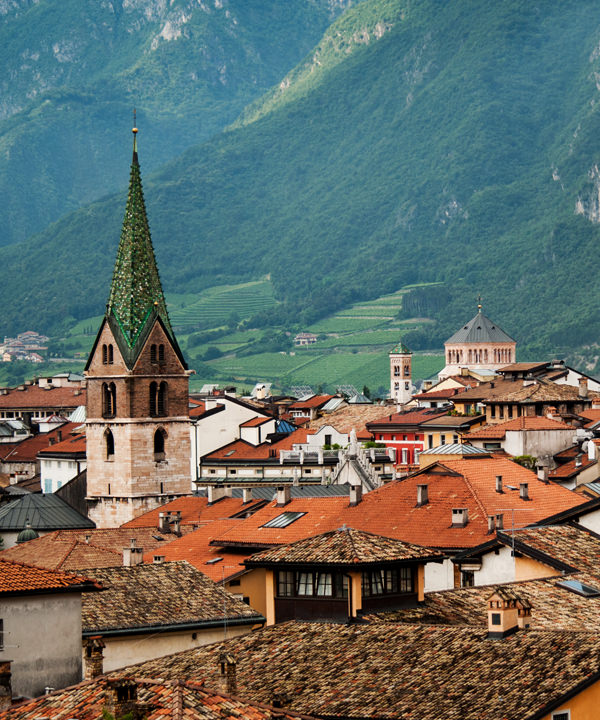
When it comes to the world of sparkling wine, Italy holds its own. The fruity, chuggable Prosecco is a brunch staple, while Franciacorta is often a top request for fans of traditional-method bubbly. But there’s another sparkling wine region that has been hiding among the Alps until quite recently, and it’s one you should really be paying attention to. Meet Trento, the region that may just have the highest potential of Italy’s sparkling wines.
Never heard of Trento? Don’t worry — you’re not alone. The region, nestled among the mountains of Trentino-Alto Adige in a series of valleys running north and south of the city of Trento, isn’t a large one. Trento DOC, or Trentodoc, as local producers have rebranded it, covers the same area as the broader Trentino DOC, but Trentodoc itself is only for sparkling wine. To put things in perspective, the appellation contains no more than 50 wineries producing 8 million bottles per year. Compare that to around 15 million bottles of the also-small Franciacorta, or the whopping 411 million bottles of Prosecco made each year, and it’s easy to see why Trento wines aren’t plastering the shelves of wine stores.
It’s interesting, then, that a region making relatively little sparkling wine — only about 10 percent of the total production of Trentino — has an entire appellation devoted to bubbly. Trentino’s tradition of sparkling winemaking actually dates back to the turn of the 20th century, when young local winemaker Giulio Ferrari studied in France and noticed similarities between the Champagne and Trentino regions. He decided to introduce Chardonnay to Trentino and make traditional-method sparkling wine, as he had learned in Épernay. It took only a few years for Ferrari’s wine to gain acclaim and win top awards, and with that, Trentino’s metodo classico status — and the origin of Trentodoc — was established.
Despite this long history, Trento remains an emerging sparkling wine region. The DOC was established less than 25 years ago, in 1993, compared to 1967 for Franciacorta. Only a few of Trento’s largest producers export wines to the U.S., such as Ferrari, Altemasi (owned by Cavit), and Rotari. It’s therefore probable that the most exciting Trento wines aren’t making it to the U.S. at all. But if Trento can follow in the footsteps of Champagne, for instance, as the region gains more prominence, smaller producers will find it easier and more profitable to expand the reach of their wines, much to the happiness of our palates. A good sign? The Istituto Trentodoc, the regional organization that represents the wines of Trento, has taken more steps recently to make the region known and to help smaller wineries showcase their wines abroad.
It’s the contrasting, picturesque climate and landscape that give Trento’s wines such potential. The mountains that form Trento’s valleys offer a key advantage: elevation. Many vineyards intended for sparkling wine are planted at varying elevations along the slopes of foothills, while grapes planted along the valley floor, where temperatures can reach over 100 degrees in the summertime, are typically used for still red wines. Thus, although Trento is located less than two and a half hours from the southwesterly Franciacorta, temperatures in these sparkling wine vineyards are much cooler, mimicking the climate of Champagne more closely. In fact, alcohol levels of Trento wines are typically a full ABV percentage point lower than the broader, richer Franciacorta wines.
Each of Trento’s valleys has a slightly different mesoclimate, creating the potential for diverse styles of wine within the region. Most wineries are located in the wide Val d’Adige, which also contains the city of Trento. The Val di Cembra is narrower, with more volcanic soil, and sees more effects of elevation. To the southwest is the Valle dei Laghi, which has a warmer, Mediterranean climate, as it’s closer in proximity to the large Lake Garda. Many producers have vineyards or source grapes from multiple areas and will blend grapes from warmer and cooler sites, but the potential to create distinctive, single-vineyard cuvées in the future certainly exists.
Regardless of where the grapes are planted, all Trento wines must be produced using metodo classico, with a secondary fermentation and aging in bottle. Chardonnay and Pinot Noir dominate the vineyards, along with Pinot Meunier and Pinot Bianco. And while lees aging requirements for Trento wines bear similarities to those of Champagne and Franciacorta — 15 months for non-vintage, 24 months for vintage, and 36 months for riserva — many producers choose to age their wines for even longer. Overall, the wines tend to be high-toned with finely textured bubbles, plus prickly minerality and acidity hitting the front and sides of the palate.
Is Trento poised to overtake Franciacorta as the Champagne of Italy? Not quite yet — the region has some work to do to develop its reputation, reach, and diversity. But keep an eye on that race in the coming years. It’s worth placing money on Trento as the winner.
